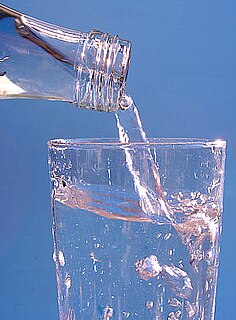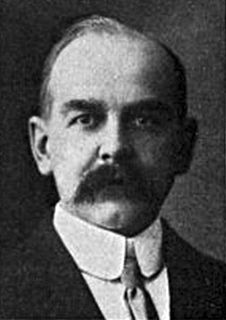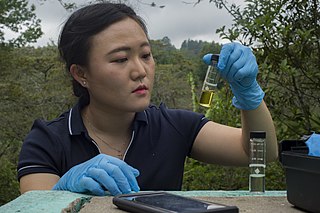
The Delaware River is a major river in the Mid-Atlantic region of the United States. From the meeting of its branches in Hancock, New York, the river flows for 282 miles (454 km) along the borders of New York, Pennsylvania, New Jersey, and Delaware, before emptying into Delaware Bay. It is the longest free-flowing river in the Eastern United States.

Drinking water is water that is used in drink or food preparation; potable water is water that is safe to be used as drinking water. The amount of drinking water required to maintain good health varies, and depends on physical activity level, age, health-related issues, and environmental conditions. For those who work in a hot climate, up to 16 litres (4.2 US gal) a day may be required. Typically in developed countries, tap water meets drinking water quality standards, even though only a small proportion is actually consumed or used in food preparation. Other typical uses for tap water include washing, toilets, and irrigation. Greywater may also be used for toilets or irrigation. Its use for irrigation however may be associated with risks. Water may also be unacceptable due to levels of toxins or suspended solids.

Water purification is the process of removing undesirable chemicals, biological contaminants, suspended solids, and gases from water. The goal is to produce water that is fit for specific purposes. Most water is purified and disinfected for human consumption, but water purification may also be carried out for a variety of other purposes, including medical, pharmacological, chemical, and industrial applications. The history of water purification includes a wide variety of methods. The methods used include physical processes such as filtration, sedimentation, and distillation; biological processes such as slow sand filters or biologically active carbon; chemical processes such as flocculation and chlorination; and the use of electromagnetic radiation such as ultraviolet light.

Tap water is water supplied through a tap, a water dispenser valve. In many countries, tap water usually has the quality of drinking water. Tap water is commonly used for drinking, cooking, washing, and toilet flushing. Indoor tap water is distributed through "indoor plumbing", which has existed since antiquity but was available to very few people until the second half of the 19th century when it began to spread in popularity in what are now developed countries. Tap water became common in many regions during the 20th century, and is now lacking mainly among people in poverty, especially in developing countries.

Water treatment is any process that improves the quality of water to make it appropriate for a specific end-use. The end use may be drinking, industrial water supply, irrigation, river flow maintenance, water recreation or many other uses, including being safely returned to the environment. Water treatment removes contaminants and undesirable components, or reduces their concentration so that the water becomes fit for its desired end-use. This treatment is crucial to human health and allows humans to benefit from both drinking and irrigation use.

Water quality refers to the chemical, physical, and biological characteristics of water based on the standards of its usage. It is most frequently used by reference to a set of standards against which compliance, generally achieved through treatment of the water, can be assessed. The most common standards used to monitor and assess water quality convey the health of ecosystems, safety of human contact, extend of water pollution and condition of drinking water. Water quality has a significant impact on water supply and oftentimes determines supply options.

Bottled water is drinking water packaged in plastic or glass water bottles. Bottled water may be carbonated or not. Sizes range from small single serving bottles to large carboys for water coolers.

Water supply is the provision of water by public utilities, commercial organisations, community endeavors or by individuals, usually via a system of pumps and pipes. Public water supply systems are crucial to properly functioning societies. These systems are what supply drinking water to populations around the globe. Aspects of service quality include continuity of supply, water quality and water pressure. The institutional responsibility for water supply is arranged differently in different countries and regions. It usually includes issues surrounding policy and regulation, service provision and standardization.

The water industry provides drinking water and wastewater services to residential, commercial, and industrial sectors of the economy. Typically public utilities operate water supply networks. The water industry does not include manufacturers and suppliers of bottled water, which is part of the beverage production and belongs to the food sector.

William Thompson Sedgwick was a teacher, epidemiologist, bacteriologist, and a key figure in shaping public health in the United States. He was president of many scientific and professional organizations during his lifetime, including president of the American Public Health Association in 1915. He was one of three founders of the joint MIT-Harvard School of Public Health in 1913.
Water supply and sanitation in the United States involves a number of issues including water scarcity, pollution, a backlog of investment, concerns about the affordability of water for the poorest, and a rapidly retiring workforce. Increased variability and intensity of rainfall as a result of climate change is expected to produce both more severe droughts and flooding, with potentially serious consequences for water supply and for pollution from combined sewer overflows. Droughts are likely to particularly affect the 66 percent of Americans whose communities depend on surface water. As for drinking water quality, there are concerns about disinfection by-products, lead, perchlorates, PFAS and pharmaceutical substances, but generally drinking water quality in the U.S. is good.

Water testing is a broad description for various procedures used to analyze water quality. Millions of water quality tests are carried out daily to fulfill regulatory requirements and to maintain safety.

American Water is an American public utility company that, through its subsidiaries, provides water and wastewater services in the United States. It offers water and wastewater services to approximately 1,700 communities in 14 states serving a population of approximately 14 million through 3.4 million customer connections. The company's customers include residential, commercial, fire service and private fire, industrial, government facilities, and other water and wastewater utilities.
Drinking water quality in the United States is generally safe. In 2016, over 90 percent of the nation's community water systems were in compliance with all published U.S. Environmental Protection Agency (EPA) standards. Over 286 million Americans get their tap water from a community water system. Eight percent of the community water systems—large municipal water systems—provide water to 82 percent of the US population.
Perfluorononanoic acid, or PFNA, is a synthetic perfluorinated carboxylic acid and fluorosurfactant that is also an environmental contaminant found in people and wildlife along with PFOS and PFOA.

Per- and polyfluoroalkyl substances (PFASs) are synthetic organofluorine chemical compounds that have multiple fluorine atoms attached to an alkyl chain. An early definition, from 2011, required that they contain at least one perfluoroalkyl moiety, –CnF2n+1–. More recently (2021) the Organisation for Economic Co-operation and Development (OECD) expanded the definition, stating that "PFASs are defined as fluorinated substances that contain at least one fully fluorinated methyl or methylene carbon atom (without any H/Cl/Br/I atom attached to it), i.e. with a few noted exceptions, any chemical with at least a perfluorinated methyl group (–CF3) or a perfluorinated methylene group (–CF2–) is a PFAS."

John Laing Leal was a physician and water treatment expert who, in 1908, was responsible for conceiving and implementing the first disinfection of a U.S. drinking water supply using chlorine. He was one of the principal expert witnesses at two trials which examined the quality of the water supply in Jersey City, New Jersey, and which evaluated the safety and utility of chlorine for production of "pure and wholesome" drinking water. The second trial verdict approved the use of chlorine to disinfect drinking water which led to an explosion of its use in water supplies across the U.S.

George Chandler Whipple was an American civil engineer and an expert in the field of sanitary microbiology. His career extended from 1889 to 1924 and he is best known as a co-founder of the Harvard School of Public Health. Whipple published some of the most important books in the early history of public health and applied microbiology.

Water chlorination is the process of adding chlorine or chlorine compounds such as sodium hypochlorite to water. This method is used to kill bacteria, viruses and other microbes in water. In particular, chlorination is used to prevent the spread of waterborne diseases such as cholera, dysentery, and typhoid.

Water contamination in Lawrence and Morgan Counties, Alabama, revolves around the presence of perfluorooctanoic acid (PFOA) and perfluorooctanesulfonic acid (PFOS) in the water supply. After the US Environmental Protection Agency (EPA) released new health advisories in March 2016, there was concern over health risks of the levels of PFOA and PFOS present. The responses of different government officials, agencies, and companies raise questions as to whether or not there was any environmental injustice involved.















